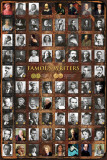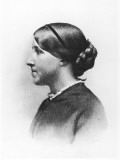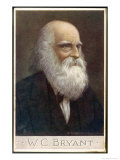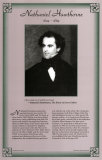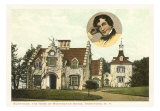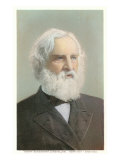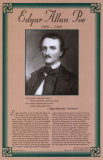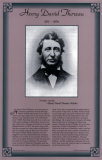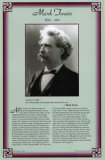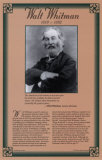|
|
19th Century American Authors Literature Educational Posters
for classrooms and homeschoolers.
|
literature posters > 19th CENTURY AMERICAN AUTHORS < social studies posters
|
|
19th Century American Authors ~
Did you know??
• William Hill Brown (1765-1793) wrote what is considered the first American novel, The Power of Sympathy.
• Suzanne Rowson was the author of Charlotte Temple (1790), the best selling novel in America until Uncle Tom's Cabin (1852).
|
|
Louisa May Alcott
b. 11-29-1832; Germantown, PA
d. 3-6-1888, MA
“My lady...had yet to learn that money cannot buy refinement of nature, that rank does not always confer nobility, and that true breeding makes itself felt in spite of external drawbacks.” Little Women
When Louisa May Alcott wrote her first novel she was just 17 years old and was dreaming about becoming an actress! But the book, a gothic tale of romance titled The Inheritance, wasn't actually published until 1997. This novel led her to give up the idea of acting to pursue a successful career as a writer. Alcott is probably best known for her novel Little Women (1868). This well-known book tells the story of the March family which was actually based on Alcott's own family. The Alcotts were always in desperate need of money, and it was mostly to help her family financially that Alcott wrote, just as the character Jo writes stories for money in Little Women. When the famous novel became a success, Alcott revealed that the story, she was the character Jo is Alcott herself, and Jo's sisters Amy, Beth, and Meg are modeled on Alcott's sisters, Meg, Elizabeth, and Anna. After the publication of Little Women, Alcott's writing was in great demand. Little Men, a sequel, was published in 1871, and her next to last book, .... was also based on the March family. Other successful Alcott books include An Old-Fashioned Girl, Eight Cousins, and A Garland for Girls. Throughout her life, Louisa May Alcott strongly supported the end of slavery, the fight for women's right to vote, and the temperance, or anti-drinking, movement. Born in 1832 in Germantown, Pennsylvania, she continued to write till her death in 1888 at age 56.
• more Louisa May Alcott posters
• more Women Writers posters
|
|
|
|
William Cullen Bryant
b. 11-3-1794; Massachusetts
d. 6-12-1878; NY
William Cullen Bryant was a romantic poet, journalist, and long-time editor of the New York Evening Post.
His most remembered poems, staples in Amercian literture curriculums, are “Thanatopsis” and “To A Waterfowl”.
“He, who, from zone to zone,
Guides through the boundless sky thy certain flight,
In the long way that I must tread alone,
Will lead my steps aright.” To A Waterfowl
• William Cullen Bryant at Amazon.com
|
|
|
|
Kate Chopin
b. 2-8-1851; St. Louis, MO
d. 8-22-1904; St. Louis, MO
“But the beginning of things, of a world especially, is necessarily vague, tangled, chaotic, and exceedingly disturbing. How few of us ever emerge from such beginning! How many souls perish in its tumult!”
The Awakening
• more Women Writers posters
|
|
|
|
James Fenimore Cooper
b. 9-15-1789; Burlington, New Jersey
d. 9-14-1851; Cooperstown, NY
James Fenimore Cooper, one of the first American authors to be widely read all over the world, is best remembered for his historical novels known as the Leatherstocking Tales, featuring frontiersman Natty Bumppo. Among his most famous works is the Romantic novel The Last of the Mohicans, often regarded as his masterpiece. He also wrote numerous sea-stories.
• “Should we distrust [a] man because his manners are not our manners?” ~ The Last of the Mohicans
• “The very existence of government at all, infers inequality. The citizen who is preferred to office becomes the superior to those who are not, so long as he is the repository of power, and the child inherits the wealth of the parent as a controlling law of society.” ~ The American Democrat
• “It is a besetting vice of democracies to substitute public opinion for law. This is the usual form in which masses of men exhibit their tyranny.” ~ The American Democrat
• “They may talk of their Jeffersons and Jacksons, but I set down Washington and Natty Bumppo as the two only really great men of my time.” Home as Found
• James Fenimore Cooper at Amazon.com
• Adirondacks Mountains were the setting for part of Cooper's Last of the Mohicans
|
|
|
|
Stephen Crane
b. 11-1-1871; Newark, New Jersey
d. 6-5-1900; Germany - tuberculosis
Prolific novelist, short story writer, poet and journalist Stephen Crane wrote in the Realist tradition as well as early examples of American Naturalism and Impressionism. Crane is recognized as one of the most innovative writers of his generation.
• more Stephen Crane posters
• Civil War posters
|
|
|
|
Emily Dickinson
b. 12-10-1830; Amherst, MA
d. 5-15-1886; MA
“That it will never come again
Is what makes life so sweet.”
Bolts of Melody
Emily Dickinson was on the most original and gifted 19th-century poets. Yet just seven of her poems were published while she lived, all anonymously, and some against her wishes. Not until 1955 did a complete collection of her poetry appear. Emily spent her life in Amherst, Massachusetts. She rarely left town. And because she was quite shy, she knew very few people. As she grew older, she became even more reclusive, seldom seeing anyone but family. In 1862, Thomas Wentworth Higginson, a well known critic, received four poems from Emily, seeking advice on her work. Higginson thought the poems were ... and very odd, his advice to her was not encouraging. But she continued to send him her work and continued to write poetry in the same unusual style. Although they often wrote, they met just twice. Higginson was said to remark that Emily's intense personality left his uncomfortably tired. “I was never with anyone who drained my nerve power so much,” he wrote. Indeed, she was intense. “If I read a book and it makes my whole body so cold no fire ever can warm me,” she wrote, “I know that is poetry. If I feel physically as if the top of my head were taken off, I know that is poetry. These are the only ways I know it. Is there any other way?” The year 1862 seems to be when Emily wrote the most poetry. Also that year the man she loved but who did not love her left Amherst for San Francisco. She began to dress entirely in white about that time. During the last ten years of her life, she would not leave her house and garden at all. Emily Dickinson died in 1886 at age 56.
• more Emily Dickinson posters
|
|
|
|
Nathaniel Hawthorne -
b. July 4, 1804; Salem, Massachusetts
d. 5-19-1864; Plymouth, NH
Poster Text:
“Life is made up of marble and mud.” The House of the Seven Gables
Nathaniel Hawthorne earned his greatest fame for two novels: The Scarlet Letter (1850) and The House of the Seven Gables (1851). But he was also a gifted short story writer, publishing more than 100 stories and sketches for magazines between 1825 an 1850. Many of his stories dealt with moral conflicts in colonial New England, where he spent much of his life. Most were collected in Twice-Told Tales (1837, 1842), Mosses from an Old Manse (1846), and The Snow Image (1851). In his stories, Hawthorne often explored such themes as the power of the imagination, the conflict between good an evil, and the role of the artist. His writing has been compared with that of Edgar Allan Poe and Washington Irving, two other great 19th-centruy writers. As a young man, Hawthorne led a fairly quiet, secluded life in his birthplace of Salem, Massachusetts, His first novel, Fanshawe, was published in 1828 at his own expense, In 1842, he married and moved to Concord, Massachusetts, where he continued writing. Then he lived in both England and Italy for a time before returning to Concord in 1860. His last major novel, The Marble Faun, was published that year. Hawthorne died in Concord in 1864 at the age of 59.
• more Nathaniel Hawthorne posters
|
|
|
|
Washington Irving
b. 4-3-1783; NYC
d. 11-29-1859; NY
Poster Text: “Whenever a man's friends begin to compliment him about looking young, he may be sure that they think he is growing old.” - Bachelors
During the 19th century, author Washington Irving became known for his humorous stories and for essays making fun of New York society. Irving worked as a lawyer in New York City for a time, but his love for writing led him to leave his law practice in 1809. That same year his first book, Knickerbocker's History of Hew York, was published. Irving's most famous works include the short stories “Rip Van Winkle” and “The Legend of Sleepy Hollow,” both of which are in the collection titled, The Sketch Book (1819-1820). “Rip Van Winkle” tells about a man who falls asleep for twenty years and wakes up to discover that the American Revolution has taken place. “The Legend of Sleepy Hollow” finds awkward schoolmaster Ichabod Crane frightened by a headless horseman. the success of The Sketch Book helped the short story gain popularity with American writers, readers, and critics. Washington Irving loved to travel, and throughout his life he visited many countries. European traditions and authors influenced his work. For example, “Rip Van Winkle” an “The Legend of Sleepy Hollow” are actually based on German folk tales. Irving became a U.S. diplomat in Spain in 1826, and his writing from this time show his interest in Spanish topics. When he returned to New York in 1832, he wrote history and biography. He then served as the U.S. minister to Spain for four years beginning in 1842. Irving died in 1859, soon after finishing a five-volume biography of George Washington. He was 76 years old.
• Washington Irving at Amazon.com
|
|
|
|
Henry Wadsworth Longfellow-
b. 2-27-1807; Portland, ME
d. 3-24-1882; Massachusetts
Poster Text:
“My own thougts
Are my companions; my designs and labours
And aspirations are my only friends.”-
The Masque of Pandorn
No other American poet has been as popular as Henry Wadsworth Longfellow was at the peak of his career. During his lifetime, Longfellow's poetry was translated into 24 languages, and he became the first American poet to be honored in the Poets' Corner of Westminster Abbey in London. Longfellow grew up in Portland, in what is now Maine. It was in college that he decided on a writing career. He graduated from Bowdoin College in 1825 and then became a language professor there. In 1836, he began to teach modern languages at Harvard. Meanwhile, his reputation as a poet was growing. His first collection of poems, Voices of the Night, was published in 1839. It sold 43,000 copies. A second collection, Ballads and other Poems, published in 1842, was also a big seller. Longfellow's poetry is quite varied. H wrote ballads and other simple poems on popular subjects such as "Paul Revere's Ride" and "The Village Blacksmith." He also wrote long, narrative poems such as The Courtship of Miles Standish, and The Song of Hiawatha. In 1854, he left teaching to write and enjoy a quiet life surrounded by friends from the literary world. The great tragedy for him during these years was the death of his wife in a fire. Longfellow grew his famous beard to cover scars left by the burns he suffered while trying to save her. After her death, he dealt with his grief by translating Dante's Divine Comedy. The sonnets he wrote as a preface to it show the sad mood of his later years. Henry Wadsworth Longfellow died in 1882 at the age of 75.
• more Henry Wadsworth Longfellow posters
|
|
|
|
Herman Melville
b. 8-1-1819; NYC
d. 9-28-1891; NYC
Poster Text: “To produce a mighty book, you must choose a mighty theme. No good an enduring volumes can ever be written on the flea, though many there nay be that have tried it.” - Moby Dick
When many people think of author Herman Melville, they think of his legendary sea story, Moby Dick. Indeed, Moby Dick is often called the Great American Novel. But in much of his other writing, Herman Melville was just as skilled in blending fact, fiction, and adventure, and his reputation should be based on more than this one book. Herman Melville was born in New York City in 1819. He left school at age 13 to find work after his father's death. He worked in a bank, for a family farm, and even as a teacher for a short time. At age 18 he set out to sea, first on a short cargo trip, and then on a three-year South Sea whaling adventure. Much of the material for his early books Typee (1846) and Omoo (1847) came from his experiences while on this long voyage. He also wrote about his sea adventures in Moby Dick (1851), Pierre (1852), and his collected stories, The Piazza Tales (1856). Other books include The Confidence Man (1857), and Battle-Pieces (1866), a collection of poetry. In his later years, Herman Melville worked as a customs inspector on the New York docks, only occasionally writing poetry. His death in 1891 at age 72 went virtually unnoticed. Melville's final novel, Billy Budd, Sailor, was left unpublished; it was released in 1924. Sadly, it was not until the 1930s that Herman Melville came to be known not only as an outstanding writer of the sea, but also a keen social observer and philosopher.
• more Herman Melville posters
• more whales posters
|
|
|
|
Edgar Allan Poe
b. 1-19-1809; Boston, Massachusetts
d. 10-7-1849; Baltimore, MD
Once upon a midnight dreary, while I pondered, weak and weary,
Over many a quaint and curious volume of forgotten lore ...
“The Raven”
Edgar Allan Poe is often called the father of the modern mystery story He was truly one of Ameria's most gifted poets, short story writers and critics. These lines from his famous poem “The Raven” are a good example of the haunting quality found in much of his strange, often terrifying work. Poe was born in 1809 in Boston. His parents both died before he was three. Young Edgar was raised by John Allan, a rich tobacco merchant in Richmond, Virginia. Edgar was an excellent student and went to the University of Virginia, but stayed only a year due to money problems. He next returned to Boston and jointed the army. By this time, he had writen his first book, Tamerlane and other Poems (1827) and had it printed at his own expense. Edgar then started writing short sotries. His most productive years were from 1837 to 1845. But, despite his success as an editor and critic his family often went without enough food. Soon his best stories were Tales of the and (1841) which included “The Pit and the Pendalum” and “The Tell-Tale Heart”. But as good as these stories were, they brought Poe neither fame nor money. Not until the publication of The Raven and other Poems (1845) did he start to become well-known. Sadly, the last years of his life were tragic. His wife died in 1847, and in his grief, Poe developed a drinking problem. In October 1849 he was found lying ... unconscious, and he died four days later at age 40. The cause of his death remains unknown.
• more Edgar Allan Poe posters
• MeOnAPumpkin stencil software - click this link for a $3 discount on MeOnAPumpkin stencil software.
|
|
|
|
Harriet Beecher Stowe
b. 6-14-1811; CT
d. 7-1-1896
“No one is so thoroughly superstitious as the godless man.” Uncle Tom's Cabin
Harriet Beecher Stowe became famous overnight for her antislavery novel Uncle Tom's Cabin (1852). Some 18,000 copies of the book were sold within the first week; 300,000 within the first year! The book has often been criticized as being overly sentimental. Yet Stowe considered slavery a .... sin and wrote the book to condemn it. Although she hoped the novel would help bring a peaceful end to slavery, it actually increased the North's hostility toward the South. Southerners in turn called Stowe's descriptions of slavery an insult to their region. Historians say the book's powerful impact fueled tensions that brought on the Civil War. The novel's main character – really the first black hero of American fiction – is a dignified slave named Uncle Tom. The story tells of Tom's experiences with three slaveholders, two who treat him well and a fiend who has him brutally beaten to death because he won't reveal the hiding places of two escaped slaves. Tom is portrayed in the novel as a brave man who would rather die than betray two fellow slaves. But he also had a humble manner, and this led some to distort the book's meaning and use the term “Uncle Tom” for blacks who are too willing to accept injustice. Much of Stowe's other work deals with everyday New England life in the 1700s and 1800s. It provides fascinating reading for anyone who seeks to better understand our author's past. Harriet Beecher Stowe died in 1894 at age 85.
• more Harriet Beecher Stowe posters
|
|
|
|
|
|
|
|
|
|
|
|
|
previous page | top
|
|
I have searched the web for visual, text, and manipulative curriculum support materials - teaching posters, art prints, maps, charts, calendars, books and educational toys featuring famous people, places and events - to help teachers optimize their valuable time and budget.
Browsing the subject areas at NetPosterWorks.com is a learning experience where educators can plan context rich environments while comparing prices, special discounts, framing options and shipping from educational resources.
Thank you for starting your search for inspirational, motivational, and educational posters and learning materials at NetPosterWorks.com. If you need help please contact us.
|
|
|








